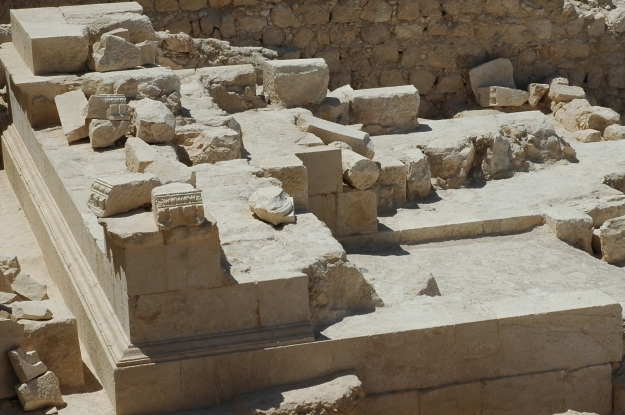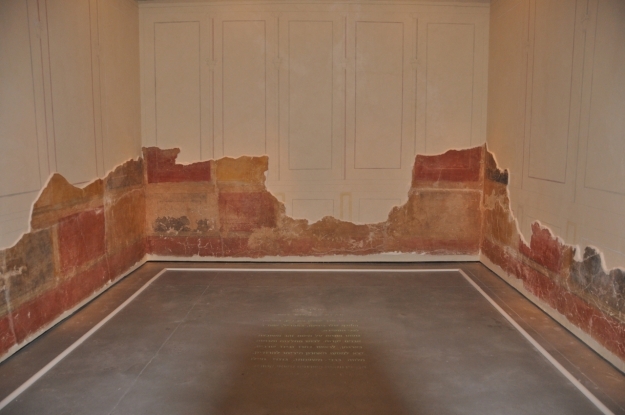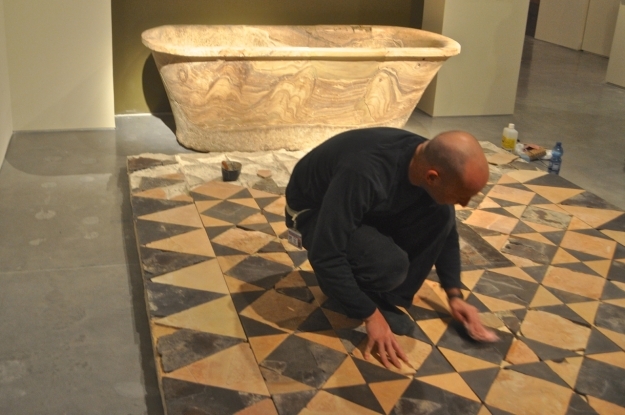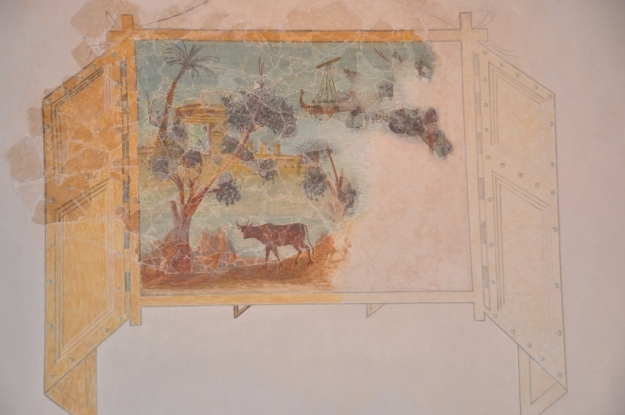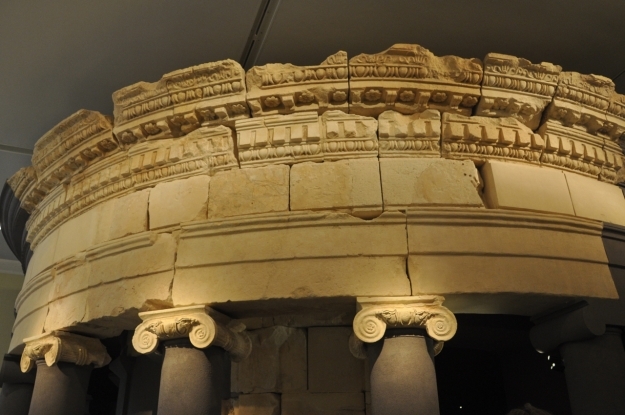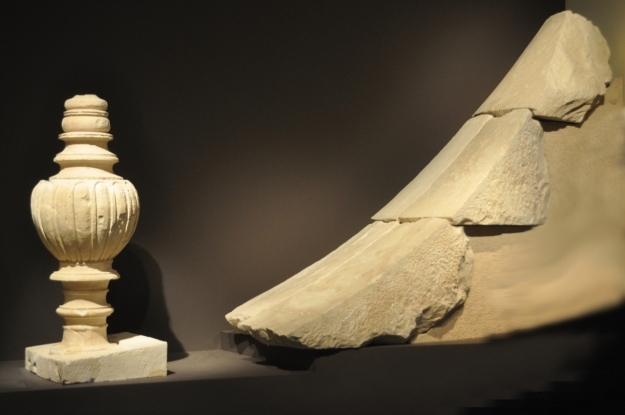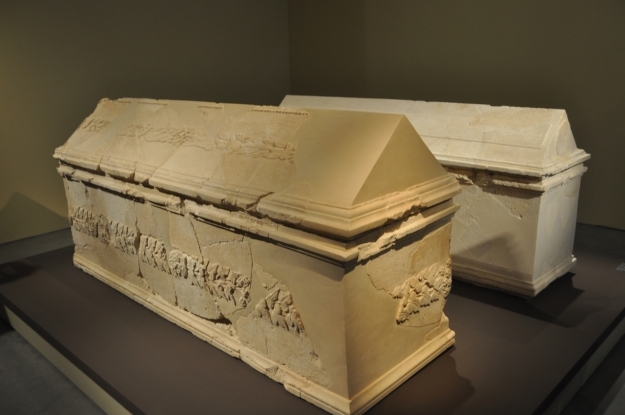Three years in the making, the Israel Museum in Jerusalem has unveiled an extraordinary showing of ancient artifacts related to Herod the Great, the first major exhibition dedicated to King Herod. Entitled “Herod the Great: The King’s Final Journey”, it is unmatched in its grandeur, befitting perhaps the great ambitions of the ancient king who is its subject. The exhibit occupies no less than 900 square meters and showcases approximately 250 artifacts, many exhibited for the first time. So weighty is the exhibit, in fact, the museum was required to reinforce its existing foundations and raise ceilings………..
Each day we rose before dawn before the unrelenting desert heat to continue digging east of the monumental staircase. In the summer of 2007, after Professor Ehud Netzer had discovered the base of the mausoleum, I volunteered at the archaeological site at Herodium. Among seas of pottery shards, we dug up baseball-sized stones hurled by a Roman catapult (ballista). Scanning with a metal detector, we found tiny, encrusted bronze coins, from the period of the Great Revolt.
_________________________________________________________________________________________
The remains of the base of King Herod’s great mausoleum. Some of the stonework is so well preserved that they appear to have been set only yesterday. Photo Shmuel Browns
______________________________________________________________________________________________________________________
We uncovered a few well-carved stones strewn about – an egg and dart pattern, two five-petaled flowers from a decorative frieze. The high-quality limestone, or meleke from the root “king”, is not local to the site; it had been brought to Herodium specially for the mausoleum. But these pieces are no longer to be found at Herodium, and not because they were looted. Today, they grace the space of the spectacular new exhibit, Herod the Great: The King’s Final Journey, in the Israel Museum in Jerusalem.
The first image at the entrance to the exhibit is neither architecture nor artifacts, but the Judean desert – the area where Herod built some of his most important monuments.
Following Herod the Builder, museum staff re-constructed three rooms from Herod’s palaces at the museum. The first room you enter (see image below) is a replica of the throne room from Herod’s third palace at Jericho, excavated by Netzer for his doctorate. The original frescoes with their intense natural colors were removed from the palace and moved to the museum. So fond of Herod, Augustus had permitted him to mine cinnabar, a red mineral pigment, from his private property in Almadén, Spain, for application at the Jericho palace.
_______________________________________________________________________________________________________________________
The throne room of the palace at Jericho. Photo Shmuel Browns
______________________________________________________________________________________________________________________
When Marcus Agrippa, Augustus’ deputy, visited Judea in 15 BCE he was so impressed by Herod’s building projects that he sent Roman builders and artists to Judea to contribute their sophisticated skills. Opus recticulatum is a technique for strengthening walls to resist earthquake damage. Three examples of this Roman technique are found in Herod’s projects, discovered by Ehud Netzer: in the palace at Jericho, at the remains of a building north of Damascus gate rumored to be Herod’s family tomb, and in a section of a temple wall at Banias.
The second room displays Herod’s private stone bathtub uncovered by Netzer at the palace in Cypros. The museum displays floors from Cypros and Herodium laid with a Roman technique, opus sectile. Natural-colored stone tiles are cut in geometric shapes and laid in repeated patterns. In other cases, the floors are mosaic, such as two mosaic floors from the bathhouse at Lower Herodian, one in an opus sectile pattern and the other with geometric shapes with pomegranates.
_________________________________________________________________________________________
Above, a view of the opus sectile floor and Herod’s private stone bathtub, all being prepared by museum staffers for the exhibit. Photo Shmuel Browns
______________________________________________________________________________________________________________________
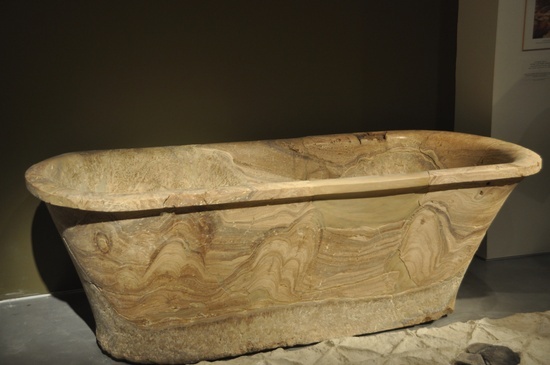 Closer view of stone bathtub found in calderium of bath-house at Cypros. Photo Shmuel Browns
Closer view of stone bathtub found in calderium of bath-house at Cypros. Photo Shmuel Browns
______________________________________________________________________________________________________________________
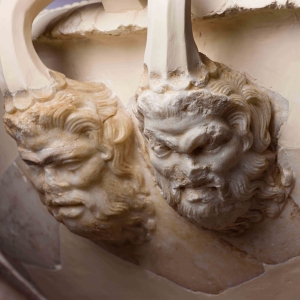 While excavating Lower Herodium, archaeologist Ehud Netzer found marble pieces of a wash basin in the bath-house, including a pair of Silenoi heads (right) – the companion and tutor of the wine god, Dionysos. Conceivably, it was a gift from the Emperor Augustus presented by his deputy Marcus Agrippa to Herod on his tour of Judea in 15 BCE and installed as a fountain. Imagine this fragile and heavy object making its journey from Greece to Rome to Judea and the bath-house at Herodium. The conservation staff of the museum painstakingly reconstructed the basin with its ornate decoration.
While excavating Lower Herodium, archaeologist Ehud Netzer found marble pieces of a wash basin in the bath-house, including a pair of Silenoi heads (right) – the companion and tutor of the wine god, Dionysos. Conceivably, it was a gift from the Emperor Augustus presented by his deputy Marcus Agrippa to Herod on his tour of Judea in 15 BCE and installed as a fountain. Imagine this fragile and heavy object making its journey from Greece to Rome to Judea and the bath-house at Herodium. The conservation staff of the museum painstakingly reconstructed the basin with its ornate decoration.
Though it is not known to what degree Herod observed traditional Jewish practices, he appears to have respected them. Aside from this basin, no other human images, in sculptural form, have been found in any of Herod’s palaces.
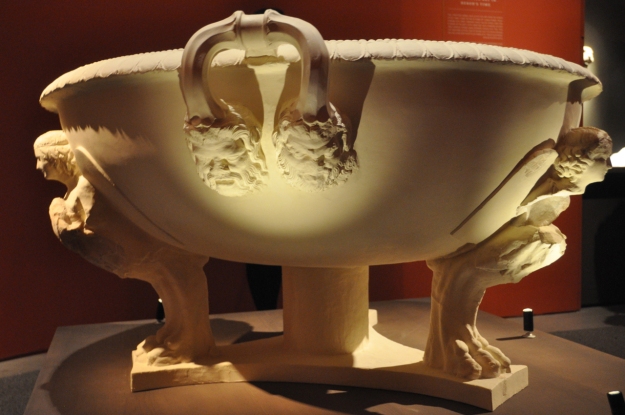
The bath-house wash basin. Photo Shmuel Browns
_________________________________________________________________________________________
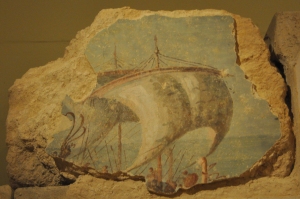 When Netzer excavated above the theater at Herodium he found the loggia, the VIP box for Herod and his guests, like Marcus Agrippa. The third room of the exhibit displays its reconstruction. Delicate trompe l’oeil paintings were on the walls, done in secco. According to this Roman technique, paint is added to dry plaster compared with the more usual fresco – a fresh, wet plaster technique. These paintings are trompe de l’oeil views of an open window with wooden shutters that look out onto a natural scene, an artistic standard found in the finest palaces and villas in Rome and Pompeii (see below). Dudi Mevorah, one of the curators of the exhibit, pointed out a painting of a boat with billowing sail (see left) on plaster from the loggia, alluding to Marcus Agrippa’s history-changing victory over Mark Anthony at the naval battle of Actium. Herod dictated the images in the paintings as a lead-in to the discussions that Herod was interested in having with his guest.
When Netzer excavated above the theater at Herodium he found the loggia, the VIP box for Herod and his guests, like Marcus Agrippa. The third room of the exhibit displays its reconstruction. Delicate trompe l’oeil paintings were on the walls, done in secco. According to this Roman technique, paint is added to dry plaster compared with the more usual fresco – a fresh, wet plaster technique. These paintings are trompe de l’oeil views of an open window with wooden shutters that look out onto a natural scene, an artistic standard found in the finest palaces and villas in Rome and Pompeii (see below). Dudi Mevorah, one of the curators of the exhibit, pointed out a painting of a boat with billowing sail (see left) on plaster from the loggia, alluding to Marcus Agrippa’s history-changing victory over Mark Anthony at the naval battle of Actium. Herod dictated the images in the paintings as a lead-in to the discussions that Herod was interested in having with his guest.
_________________________________________________________________________________________
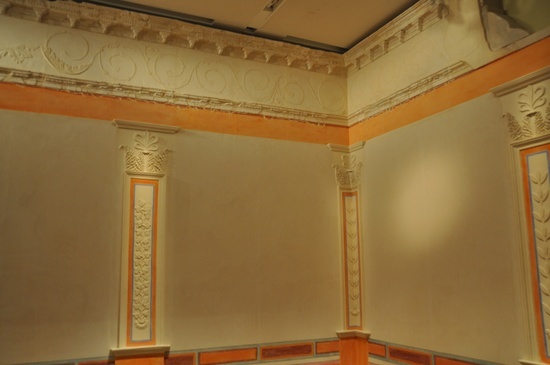 Reconstructed loggia, Herod’s VIP room above the theater. Photo Shmuel Browns
Reconstructed loggia, Herod’s VIP room above the theater. Photo Shmuel Browns
_______________________________________________________________________________________________________________________
Done in secco, the trompe de l’oeil view of an open window with wooden shutters, looking out onto a natural scene. Photo Shmuel Browns
_______________________________________________________________________________________________________________________
The exhibit is laid out faithfully to the site at Herodium where the loggia and the mausoleum flank the staircase. At the museum, we move through the viewing platform toward the full life-size reconstruction of the top-level of the mausoleum (see below). The very decorative stones I excavated at Herodium are in their proper places in the frieze. A microchip was attached to each stone of 30 tons that were transported from Herodium to the Museum – as an aid to tracking and assembly. For the same purpose, the Hebrew letter “chet” can be seen on one stone, a sign left by the ancient Jewish stone masons. The structure is so heavy that the floor had to be specially reinforced.
______________________________________________________________________________________________________________________
The top level of the mausoleum. Photo Shmuel Browns
______________________________________________________________________________________________________________________
In 1982, while Netzer was excavating, he came upon a water cistern in the mountain. He was puzzled that the cistern had been reinforced to support a great weight. Unbeknown to him, he had come within a meter of discovering the mausoleum. Why would Herod have insisted that the mausoleum be built on top of a cistern? According to the curator, Dudi Mevorah, Herod chose this precise location because it is best seen from Jerusalem. Once the mausoleum was complete, Herod dismantled the stage and buried his theater in order not to distract the eye.
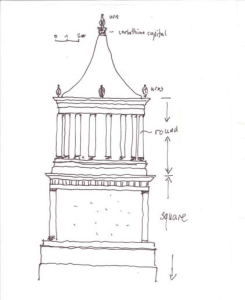 Netzer drew on his familiarity with Herod’s oeuvre and his expertise as an architect and archaeologist to imagine the mausoleum. Netzer conceives a colossal three-story monument – 25 meters high (see drawing, right, courtesy Israel Museum). The first level is cube-shaped – only the base exists and can be viewed at Herodium halfway up the mountain on the north side. The second level is a tholos, a cylindrical structure with Ionic columns and crowned with a conical roof. In addition to the Roman style, there are Nabatean elements to memorialize Herod’s Nabatean mother Cypros – two stone replicas of Nabatean funerary urns are on display out of five that adorned the roof (see below).
Netzer drew on his familiarity with Herod’s oeuvre and his expertise as an architect and archaeologist to imagine the mausoleum. Netzer conceives a colossal three-story monument – 25 meters high (see drawing, right, courtesy Israel Museum). The first level is cube-shaped – only the base exists and can be viewed at Herodium halfway up the mountain on the north side. The second level is a tholos, a cylindrical structure with Ionic columns and crowned with a conical roof. In addition to the Roman style, there are Nabatean elements to memorialize Herod’s Nabatean mother Cypros – two stone replicas of Nabatean funerary urns are on display out of five that adorned the roof (see below).
Photo Shmuel Browns
_______________________________________________________________________________________________________________________
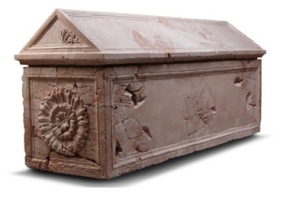 Entering within the structure, one sees the sarcophagus (left) that Netzer claims was Herod’s. Netzer found its shards – the stone box had been smashed in antiquity and reconstructed by museum staff.
Entering within the structure, one sees the sarcophagus (left) that Netzer claims was Herod’s. Netzer found its shards – the stone box had been smashed in antiquity and reconstructed by museum staff.
Made of reddish limestone, mizzi ahmar, from the Arabic, this is very hard stone and would have been difficult to carve – perhaps that made it all the more appealing. Originally, Netzer suggested that the side panels of the sarcophagus were decorated with five flower medallions. There are sarcophagi like that, one in the Louvre taken from the Tomb of the Kings, and one outside the Islamic museum on the Haram el-Sharif. Based on the museum reconstruction, it appears that these panels are plain.
Beside the mausoleum, the other two sarcophagi (see below) that Netzer discovered are displayed. Netzer posits that these belonged to Herod’s family members. One is decorated with a vine pattern – very similar to the stucco decorations in Herod’s theater box. The other sarcophagus, displayed for the first time, is completely plain, as if waiting for the stone-carver.
_________________________________________________________________________________________
Photo Shmuel Browns
______________________________________________________________________________________________________________________
Finally, the exhibit features scores of artifacts that hint at the taste for the luxury and sumptuous life of Herod’s private and public world and his inner circle. Some examples are shown below.
_________________________________________________________________________________________
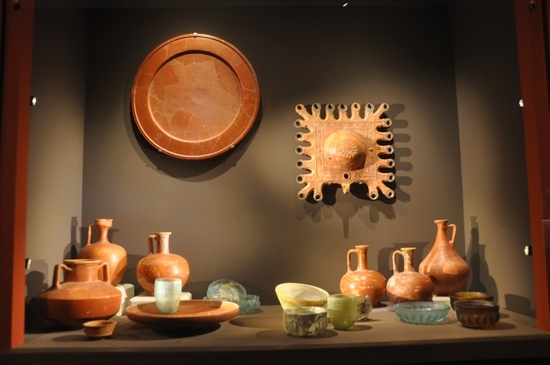 Artifacts: Terra sigillata pottery and Roman glass from Herod’s palaces. Photo Shmuel Browns
Artifacts: Terra sigillata pottery and Roman glass from Herod’s palaces. Photo Shmuel Browns
______________________________________________________________________________________________________________________
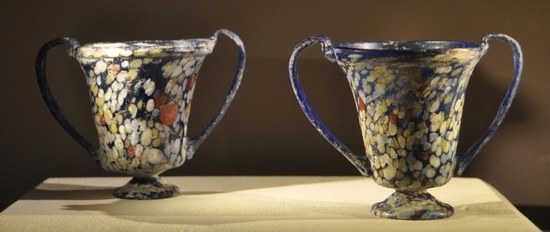 Glass drinking cups from the time of Augustus. Photo Shmuel Browns
Glass drinking cups from the time of Augustus. Photo Shmuel Browns
_____________________________________________________________________________________________________________________
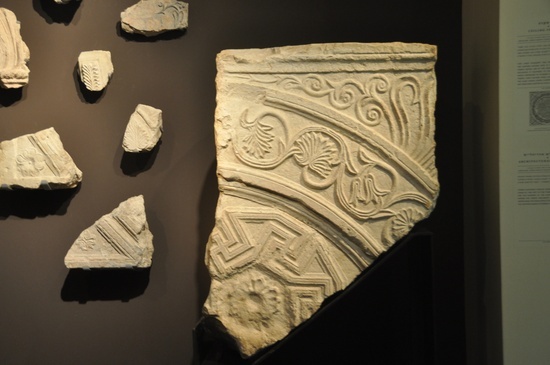 Stone fragments found near Hulda gate near the location of the ancient Temple Mount. Photo Shmuel Browns
Stone fragments found near Hulda gate near the location of the ancient Temple Mount. Photo Shmuel Browns
______________________________________________________________________________________________________________________
The Israel museum has built a monumental exhibit that expresses Herod’s architecture and aesthetics as discovered by archaeologist, Professor Ehud Netzer – Herod would have been pleased with the result. To understand more requires going beyond the exhibit halls to experience the drama of Herod’s life in situ, at the sites that Herod built.
The author is offering a Herod the Great tour that combines a comprehensive tour of Herodium and the Israel museum. See
http://israeltours.wordpress.com/herod-the-great-tour/ for more information.
____________________________
Photo of Herod’s sarcophagus, courtesy The Israel Museum/Meidad Suchowolski.

